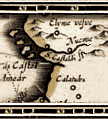







|
|
|
|
Alberich, Stone God of the DwarvesVery little is known of dwarvish religions, although there is great speculation that the dwarves have a long tradition of philosophy. The dwarvish Clan Wars of 600 years ago quite possibly were started because of a conflict of philosophical beliefs. Regardless, the ancient dwarven god Alberich has always weighed heavily in dwarvish lore. According to the oldest dwarvish myths, it is upon the spine of Alberich that Arcanum rests, and the dwarves are his first children who are privileged to live within him. Alberich is the most ancient of things, and loves those who are slow to anger, deep of thought and hardworking. He sings to his children in the shiftings of mountains, in the roar of volcanoes, and whispers to them in the still air of long forgotten caverns, deep underground. To the altars of Alberich, dwarves bring chunks of lava rock. To them it represents his anger, which can be terrible, but which is cool and light when all is well with his children. Makaal, the Bedokaan God of the HuntLittle is known of the Bedokaan. Lizard-like creatures that travel in nomadic tribes, the Bedokaan have lived within the swamps of the Dark Fens for millennia. Sir Warren Purrington, the famous 16th century gnomish explorer, left perhaps the only true account of them or their ways. The following is an excerpt from "Fauna and Specie of the Darke Fens." "I've discovered a most unusual tribe of creatures, covered in scale and slime, who call themselves the Bedokaan. Apparently, they've never seen any of what I'd call the 'civilized races', whether gnomish or otherwise. They have language, and the most elementary beginnings of culture, but besides that seem altogether wild and ferocious. Their simple religion revolves around deities they call the Snake-fathers, one of whom is a being named Makaal, the god of the Hunt. Before their daily outings to find food, Bedokaan warriors kneel before the altar of Makaal, and offer small pieces of something they call Heartstone, which looks to be some form of rough diamond or crystal. Where they get them, I've yet to ascertain. Bedokaan warriors believe that the offerings to Makaal give them speed when hunting their prey. Truly, these are a primitive people." One-armed Bolo, the Halfling God of ThievesHalfings have always been fond of trickery, so it is no surprise that one of their most important ancient deities was Bolo, the one-armed god of Thieves. Bolo was known for his cunning ways, and his love of all things precious and beautiful. Legend tells that Bolo was so skilled at thievery, that he once stole the shadow of Progo, who was Bolo's stepfather and god of the Storm. Unfortunately, Bolo was careless, and was noticed by Progo. As punishment, Progo cut off one of Bolo's arms; in retaliation Bolo stole his stepfather's soul, tore it in half and Progo dropped dead. Lightning, it is said, represents the skillful cut of Progo, and thunder his death roar. Halfings used to offer rings at the altars of Bolo. Rings, they said, reminded them of the price that Bolo paid for his carelessness, as well as the skill he still possessed in his remaining hand. Kerlin, the Golden God of the GnomesGnomish history is well guarded, as are their most ancient beliefs and traditions. But a visit to any gnomish household will reveal at least one of their religious traditions...one will invariably find a golden statuette, or likeness thereof, of Kerlin, the Golden God. Kerlin was the oldest of the gnomish pantheon, and all other gods were sprung directly from the palms of his hand. He sung the world into existence, and the sound solidified into great veins of gold and silver. Kerlin wanted only those things made of his words, and so gnomish offerings were always of money, usually of the small, ancient gnomish coins known as Mnura. |